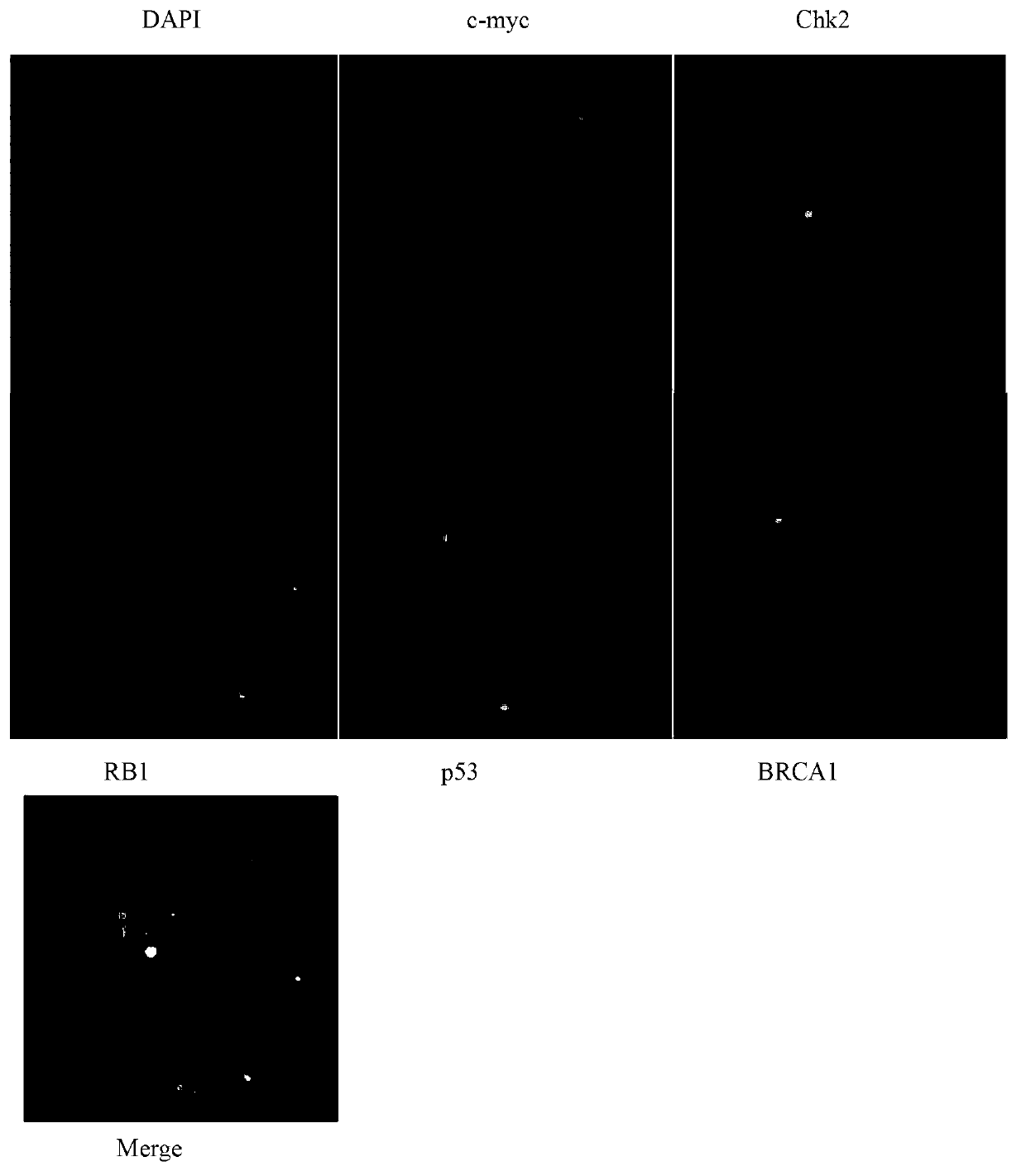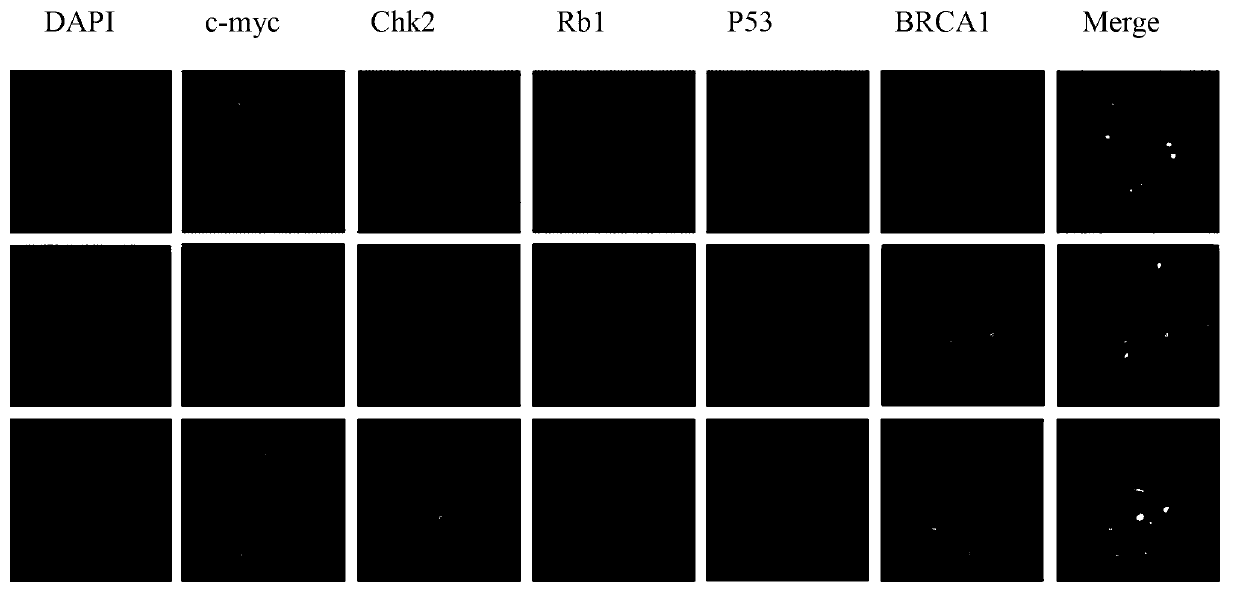Gene probe composition and kit for detecting epithelial ovarian cancer
A technology of gene probe and composition is applied in the field of gene probe composition and kit for detecting epithelial ovarian cancer, and can solve the problems of low incidence and the like
- Summary
- Abstract
- Description
- Claims
- Application Information
AI Technical Summary
Problems solved by technology
Method used
Image
Examples
Embodiment 1
[0090] Embodiment 1: The preparation method of BRCA1 gene probe comprises the following steps:
[0091] 1. Clone screening: The BRCA1 gene is located in the 21.2-21.31 segment of the long arm of human chromosome 17 (17q21.2-q21.31), and all clones containing the BRCA1 gene were searched in the UCSC genome browser, NCBI Clone Registry, and Ensembl Genome Browser databases, and screened The optimal clone containing the gene was obtained, numbered RP11-831F13 (as shown in Table 1).
[0092] 2. Cloning culture and identification: purchase clone RP11-831F13 (Invitrogen, USA), take 8 microliters of clone bacteria liquid and add it to 5 milliliters of LB liquid medium containing chloramphenicol resistance, shake and activate at 37°C for 12 hours ; Then add all the bacterial liquid to 450 ml of LB liquid medium containing chloramphenicol resistance, and collect the bacterial liquid after shaking and culturing at 37° C. for 12 hours. Use upstream primer: TAGGGCTGGAAGCACAGAGT (SEQ ID N...
Embodiment 2
[0119] Embodiment 2: the preparation method of c-myc, Rb1, Chk2, p53, BRCA1 gene probe composition, comprises the following steps
[0120] 1. Clone screening:
[0121] By searching UCSC genome browser, NCBI Clone Registry, Ensembl Genome Browser and other databases contain all clones of c-myc, Rb1, Chk2, p53, BRCA1 genes respectively. The optimal clones containing the gene were screened out, and the numbers were: RP11-440N18, RP11-305D15, RP11-73I4, RP11-1081A10, RP11-831F13. (As shown in table 2)
[0122] 2. Cloning culture and identification: Purchase the clone according to the clone number (Invitrogen, USA), take 8 microliters of the clone bacteria solution and add it to 5 milliliters of chloramphenicol-resistant LB liquid medium, shake and activate at 37°C for 12 hours ; Then add all the bacterial liquid to 450 ml of LB liquid medium containing chloramphenicol resistance, and collect the bacterial liquid after shaking and culturing at 37° C. for 12 hours. The bacteria l...
Embodiment 3
[0160] Example 3: A fluorescent in situ hybridization detection kit for epithelial ovarian cancer (50 servings), the composition is as follows:
[0161] 1) Fluorescence-labeled probe set hybridization mixture 100 microliters; 1 tube
[0162] 2) DAPI counterstain solution 500 microliters; 1 tube
[0163] 3) 20ml of 20XSSPE washing solution; 1 bottle
[0164] 4) 1 instruction manual.
[0165] Wherein the concentration of the c-myc gene probe in the hybridization mixture of the fluorescently labeled probe group is: 4ng / μl, the concentration of the Rb1 gene probe is: 4ng / μl, the concentration of the Chk2 gene probe is: 4ng / μl, and the concentration of the p53 gene probe 4ng / μl, BRCA1 gene probe concentration: 4ng / μl.
PUM
| Property | Measurement | Unit |
|---|---|---|
| molecular weight | aaaaa | aaaaa |
Abstract
Description
Claims
Application Information
 Login to View More
Login to View More - R&D
- Intellectual Property
- Life Sciences
- Materials
- Tech Scout
- Unparalleled Data Quality
- Higher Quality Content
- 60% Fewer Hallucinations
Browse by: Latest US Patents, China's latest patents, Technical Efficacy Thesaurus, Application Domain, Technology Topic, Popular Technical Reports.
© 2025 PatSnap. All rights reserved.Legal|Privacy policy|Modern Slavery Act Transparency Statement|Sitemap|About US| Contact US: help@patsnap.com



